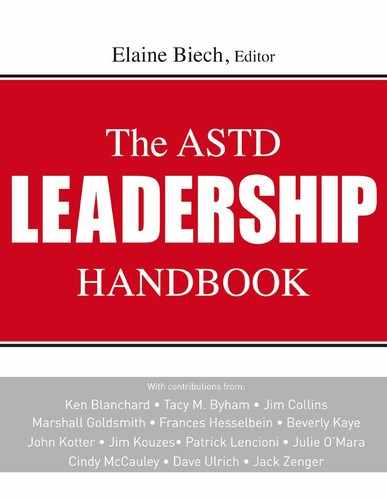 Section II
Section II
Leadership Development
What keeps your organization’s leaders up at night? Most leaders will tell you that it is a lack of talent, and most specifically the talent—the skills and capabilities—it will take to lead the organization. Does the organization have the talent in the next generation of leaders, the bench strength, to carry out its strategy and meet its goals?
The most critical investment any organization can make is in choosing and developing its future leaders. Some organizations rely on a generic model with the same leadership competencies as every other organization: setting direction, managing change, delivering results, building teams, and inspiring employees. Indeed, these are critical leadership skills—a place to start. But they are just the beginning of a solid leadership development program.
The specific competencies are no secret. Most organizations groom their leaders in these skills. However, successful organizations need more than a list of competencies. Because each organization faces its own challenges, has its own goals, and maintains its own reputation, it seems logical that it also needs to ensure that its leaders have the specific skills and capabilities required to carry out the strategy. The upcoming leaders must deliver a competitive advantage.
The most successful organizations link their leadership development plan to the organization’s strategy, its culture, and its vision for the future. The six chapters in this section address the “how” of developing leaders:
- How do you define an effective leadership development strategy?
- How do you identify the right competencies?
- How do you avoid making mistakes with 360-degree feedback?
- How can you use mentoring by other leaders?
- How can you enhance the potential for learning on the job?
- How can you use coaching to change behavior?
In chapter 11, “Leadership Development Strategy,” the daughter-father team of Tacy By-ham and William Byham present five strategies for individual leadership development and delineate the roles of both the developing leaders and their supervisors.
In chapter 12, “Identifying Real-World Leadership Competencies,” Mark David Jones presents his findings from interviews with leaders of successful corporations to show why leadership competencies are important and how to identify competencies connected to corporate culture and the organizational brand.
For chapter 13, “Worst Practices in 360-Degree Assessments: Why Feedback Fails,” we are fortunate to have an author with Craig Chappelow’s immense experience with 360-degree assessments. Here he takes a how-not-to approach, which we hope will help you learn from others’ mistakes.
In chapter 14, “Leaders as Mentors and Teachers: Time-Tested Leadership Development Strategies,” Edward Betof explains the benefits of using leaders as mentors and teachers of other leaders. You will find that the learning benefits both mentors and learners.
Don’t let the simple title of chapter 15, “Learning on the Job,” fool you; this chapter by Ellen Van Velsor is filled to overflowing with information about what people learn and how they learn on the job. The chapter tackles the conundrum of why learning from experience can be difficult and what can be done to enhance the potential for learning on the job.
In chapter 16, “Coaching Leaders to Lead,” Marshall Goldsmith—who is considered one of the top leadership coaches in America and is certainly one of the most recognized—presents his simple but effective coaching process to assist in encouraging leadership growth.
The topic of this section could easily take up several handbooks—or an encyclopedia’s worth! If you want more depth, a great companion to this section is the Center for Creative Leadership’s Handbook of Leadership Development, edited by Cynthia McCauley and Ellen Van Velsor, who are both authors of chapters in the present handbook.
